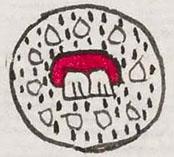Xallan (Mdz40r)
This compound glyph for the place name Xallan (perhaps "Near the Sand") features sand (xalli) as black dots and small circles inside of a bigger circle. Presumably, this is a bird's eye view of a sandy ground. The two, white, front teeth (tlantli) with red gums, in a frontal view, provide the phonetic value for the locative suffix (-tlan), by or next to.
Stephanie Wood
The bird's eye view of the sandy place is reminiscent of the way market places are shown in the Codex Mendoza. Markets can also have a sandy ground in the center. See below for two examples. Also, go to the Advanced Search, shapes category, and click bird's eye view for additional examples. Land parcels are often seen from above, as are soil types.
When the final "l" of the stem "xal-" meets the starting "tl-" of the locative -tlan, the "t" drops away and the double "l" remains. We have retained the final "n" of -tlan, even though the gloss does not show the place name ending in "n."
Stephanie Wood
xala.puo
Xallan, pueblo
Stephanie Wood
c. 1541, or by 1553 at the latest
Stephanie Wood
arena, dientes, nombres de lugares

xal(li), sand, https://nahuatl.wired-humanities.org/content/xalli
tlan(tli), tooth/teeth, https://nahuatl.wired-humanities.org/content/tlantli
-tlan (locative suffix), by, among, next to, https://nahuatl.wired-humanities.org/content/tlan
Arenal
Stephanie Wood
Codex Mendoza, folio 40 recto, https://digital.bodleian.ox.ac.uk/objects/2fea788e-2aa2-4f08-b6d9-648c00..., image 90 of 188.
The Bodleian Libraries, University of Oxford, hold the original manuscript, the MS. Arch. Selden. A. 1. This image is published here under the UK Creative Commons, “Attribution-NonCommercial-ShareAlike 3.0 License” (CC-BY-NC-SA 3.0).




